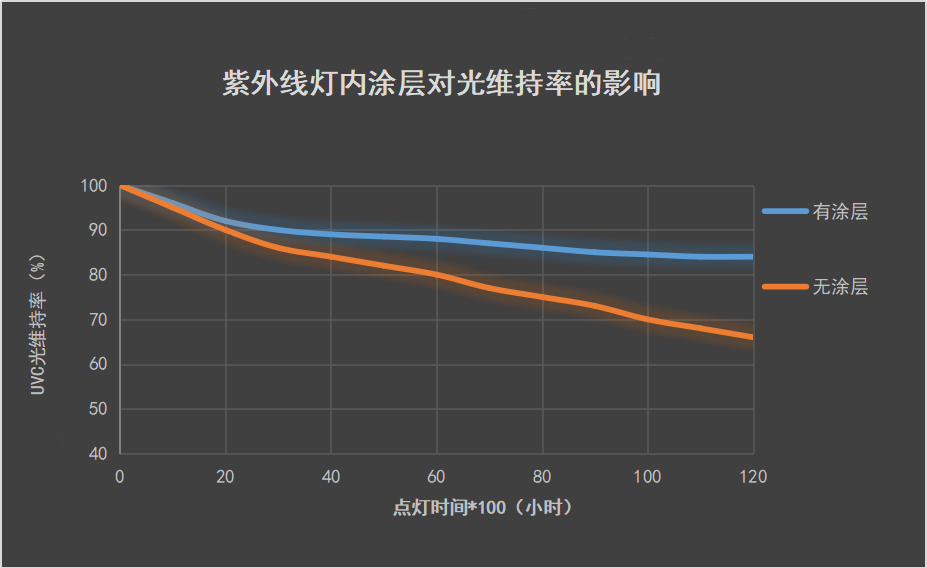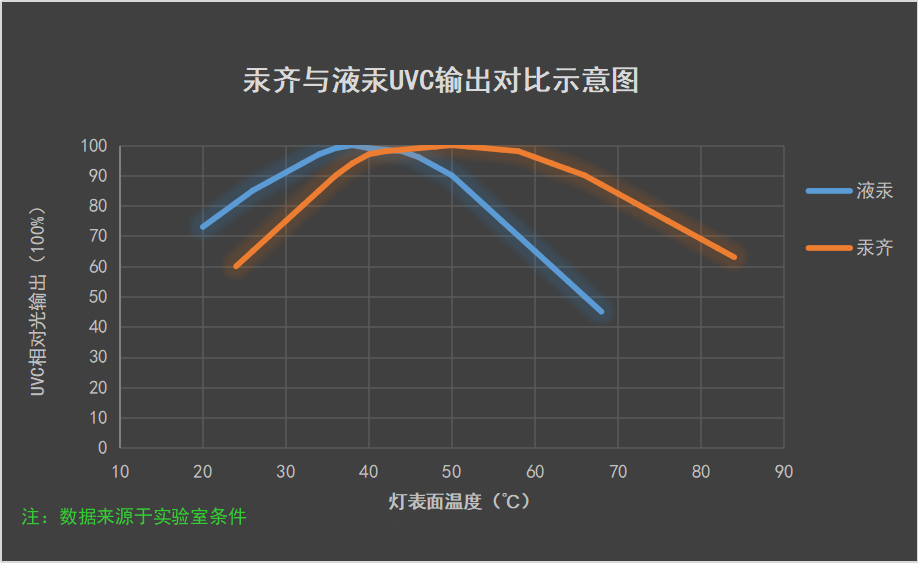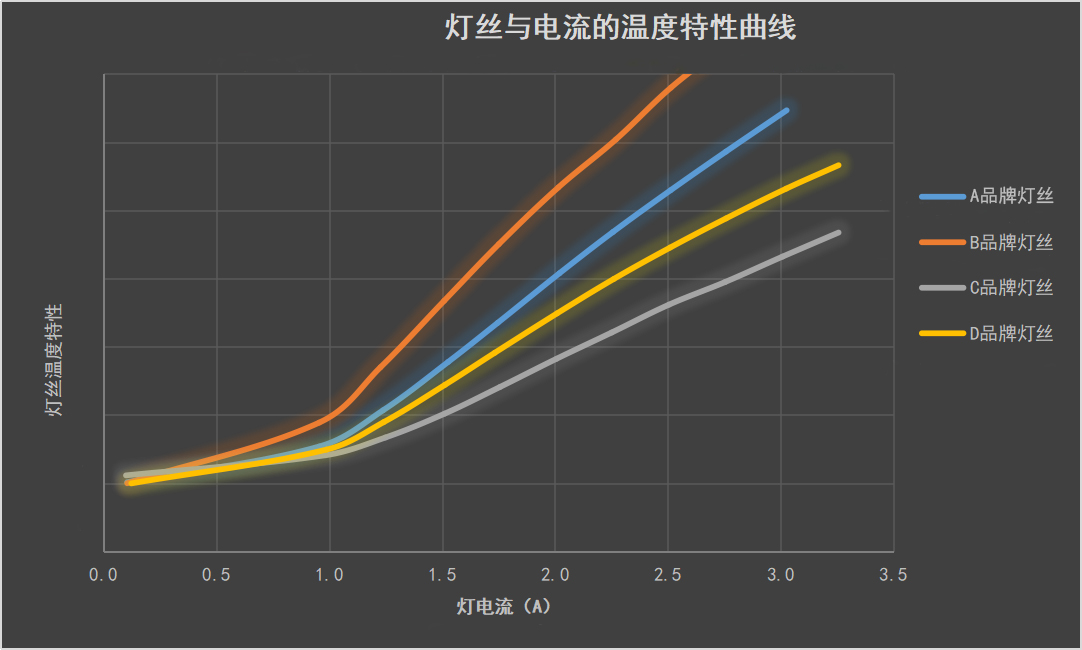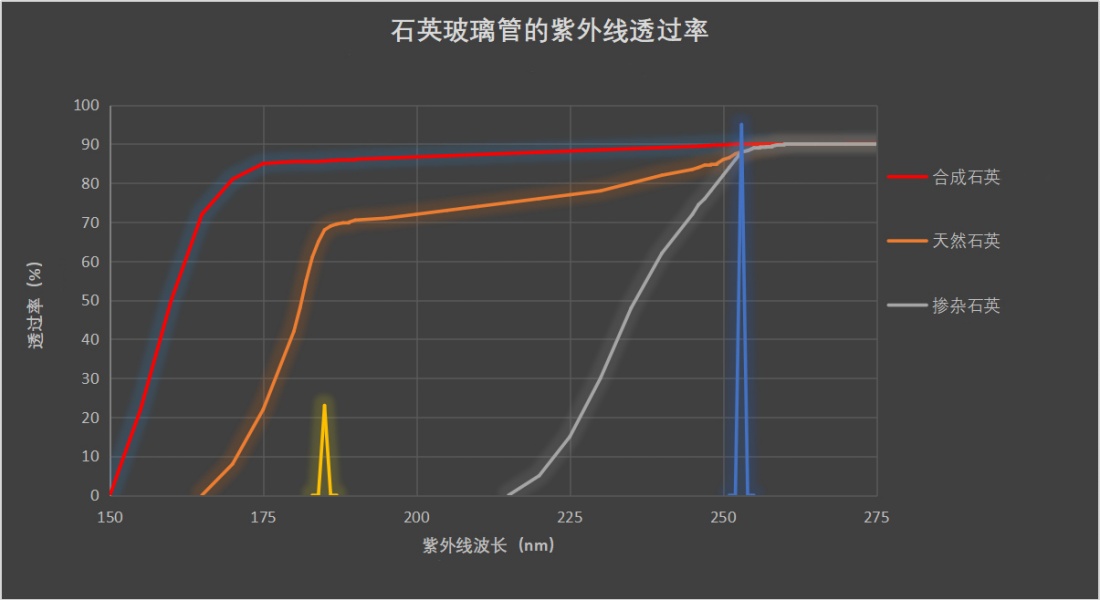Core Technology
-
Tube Coating Technology
- The inner wall of the quartz glass tube used for high-quality UV lamps is coated with an oxide coating, which can effectively prevent the mercury in the lamp from combining with the impurities in the tube to form black or yellow compound sediments, thereby reducing the ultraviolet light transmittance of the quartz glass tube; After using the coating, the UV lamp can maintain a relatively high ultraviolet output (≥85%) within 12000 hours. The coating is with the following characteristics:
● The coating is with extremely high purity;● Extremely low absorption rate of 100~280nm wavelength ultraviolet;● Firmly attached to the inner wall of the quartz tube;● The coating is dense, continuous and uniform; 
-
Amalgam Technology
- Traditional ultraviolet lamps use liquid mercury as the luminous filler in the tube cavity. However, as the lamp power increases, the temperature of the tube wall increases, and the temperature of the operating environment increases, the ultraviolet radiation intensity of the UV lamp using liquid mercury process will be greatly reduced; The UV lamps using amalgam as luminous filler have greater application advantages than traditional liquid mercury UV lamps.
● Under high temperature conditions, the ultraviolet radiation intensity is much higher;● It has a wider application temperature range. Within a specific temperature range, the ultraviolet radiation basically maintains no fluctuation or small fluctuations when the ambient temperature fluctuates;● The lighting direction of the lamp is not restricted, and it can installed in any direction to match with the equipment;● Effectively reduce the amount of mercury used in the lamp, which is conducive to the disposal and recycling of waste lamps, and it is much more environmentally friendly;● Low temperature amalgam (replacement of liquid mercury type): It has the same characteristics as liquid mercury, which can effectively reduce the amount of mercury injected in the lamp;● Medium temperature amalgam, used in the scene of the ambient temperature range of 40~100℃, to ensure that the UV output intensity does not decrease;● High temperature amalgam, used in scenes where the ambient temperature is greater than 100°C, to ensure that the UV output intensity does not decrease;★ Our company could design amalgam ultraviolet lamps to match different application scenarios according to the needs of customers, to escort the processes of disinfection, sterilization and advanced oxidation. 
-
Electrode Design
- The electrode of the ultraviolet lamp is the heart of the lamp and the bridge between the lamp and the ballast. The electrode mainly includes two core components. One is a spiral filament, which is wound by a high-purity tungsten wire under a high-temperature through a special process; The other is the electronic powder material coated on the surface and inside of the filament (ternary Carbonate and additives with specific functions), which are indispensable materials to maintain lamp conduction and gas discharge. High-quality ultraviolet lamp electrodes should have the following characteristics:
● Matching with the output characteristics of the ballast, which is to meet the requirements of the lamp to be perfectly matched with the ballast under preheating, starting and normal ignition;● High storage capacity of electronic powder, and with good anti-bombardment performance (usually adopting the main and auxiliary four-wires and triple helix structure);● Good mechanical properties, to ensure that the filament will not be brittle and the electronic powder will not fall off under the conditions of transportation, lighting, equipment vibration, etc.★ According to customer's ultraviolet lamp requirements, our company could design and manufacture filaments with different shapes (horizontal type, vertical type, etc.) and different lamp currents (1~10A) to meet the electrical parameter requirements of different power ultraviolet lamps. 
-
Quartz Tube
- The quartz glass shell of the ultraviolet lamp, which constitutes a closed cavity,after "exhausting and charging" process in the production of the lamp, provides a good internal environment for the gas discharge the generation of ultraviolet rays. , The ultraviolet light generated in the gas discharge process is transmitted through the quartz glass shell, which is the first medium material for ultraviolet transmission. Currently, the quartz glass used in the manufacture of ultraviolet lamps mainly includes the following three types, and the transmittance of 185nm and 253.7nm wavelength ultraviolet light is not exactly the same:● Synthetic quartz tube: It is made by chemical vapor deposition (CVD) process and with SiCl4 as raw material. It has the characteristics of high purity and high light transmittance. The UV transmittance at 185nm is greater than 80% and at 253.7nm the UV transmittance rate is greater than 90%. It is mostly used in the fields of semiconductor, ultrapure water, surface modification, water disinfection, and organic wastewater purification;
● Natural quartz tube: It is made by smelting and purifying process and with natural silica as raw materials . The glass tube made of high-grade raw materials has a UV transmittance of more than 65% at 185nm and at 253.7nm the rate is greater than 87%. It is mostly used in the fields of semiconductors, ultrapure water, surface modification, water disinfection, and air purification;● Doped quartz tube: In the production process of the quartz tube, a small amount of oxide material that can absorb and cut off the 185nm wavelength ultraviolet light, such as titanium oxide, is added to allow 253.7nm ultraviolet light to be transmitted only. The ultraviolet transmittance at 185nm is basically is 0, and the ultraviolet transmittance at 253.7nm is greater than 87% for this type of quartz tube, which is mostly used in the fields of water disinfection and air disinfection and purification;★ Our company can comprehensively design specific-purpose UV lamp products with cost efficient but high performance according to customers' application requirements and application scenarios. 
-
Water Temperature Fluctuation Adaptation Technology
- When the ultraviolet lamp is used for water treatment, the application environment of the lamp is completely different from that in the air. The parameter performance of the lamp in the air can not be used to measure the effect of the lamp in the water; At the same time, due to the influence of the season and region, the temperature of the water fluctuates accordingly, and the temperature fluctuation of the water will affect the surface temperature of the lamp, so that the ultraviolet output intensity of the lamp will fluctuate accordingly. Therefore, in the water treatment applications, the relative UVC output fluctuation shall be less than 10% for high-quality ultraviolet lamp when the water temperature fluctuates within the range of 5~40℃.


 CN
CN RU
RU




